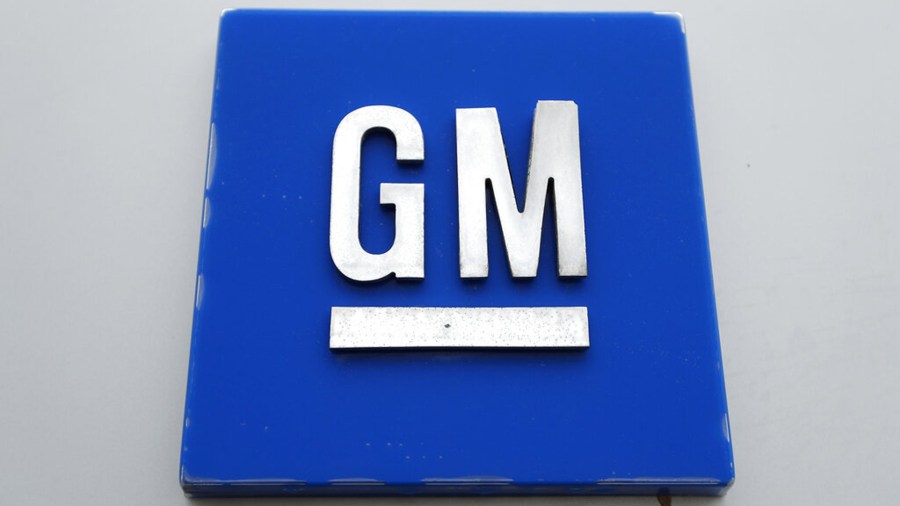Business
GM recalling hundreds of vehicles over potentially exploding Takata air bag inflators on August 1, 2023 at 2:29 pm Business News | The Hill

DETROIT (AP) — General Motors is recalling nearly 900 vehicles in the U.S. and Canada with Takata air bag inflators that could explode and hurl shrapnel in a crash.
The recall covers certain Chevrolet Camaro, Sonic and Volt vehicles as well as the Buick Verano, all from the 2013 model year. Some 2013 Chevrolet Trax versions in Canada also are included.
The company says in documents posted Tuesday by the U.S. National Highway Traffic Safety Administration that the driver’s front air bag inflator can explode in a crash due to a manufacturing defect.
The inflators are among a group made by Takata that is under investigation by the agency but has not previously been recalled.
Takata used volatile ammonium nitrate to create a small explosion to inflate air bags in a crash. But the chemical can deteriorate over time and explode with too much force, blowing apart a metal canister and spewing shrapnel.
At least 26 people have been killed in the U.S. by the inflators since May of 2009, and more than 30 have died worldwide including people in Malaysia and Australia. In addition, about 400 people have been injured.
Potential for the dangerous malfunction led to the largest series of auto recalls in U.S. history, with at least 67 million Takata inflators involved. The U.S. government says that millions have not been repaired. About 100 million inflators have been recalled worldwide. The exploding air bags sent Takata Corp. of Japan into bankruptcy.
The air bags in the General Motors recall have a moisture-absorbing chemical called a dessicant and were not part of previous recalls. GM says in documents posted by the government that the problem is limited to a specific lot of inflators made by Takata, and that other vehicles are not affected.
But Takata air bags with a dessicant are under investigation by NHTSA because they have the potential to explode and expel shrapnel. The investigation opened in 2021 covers more than 30 million inflators in over 200 models from 20 car and truck makers, including GM.
The agency decided in May of 2020 not to recall the inflators with the dessicant, but said it would monitor them.
“While no present safety risk has been identified, further work is needed to evaluate the future risk of non-recalled dessicated inflators,” the agency said in a document opening the probe.
GM says in documents that it was notified in March that an inflator exploded in a 2013 Camaro in Brazil in May of 2022. The company says an analysis of the inflator is still under way, but initial findings indicate the inflator rupture is related to a manufacturing defect and was not caused by deterioration of the ammonium nitrate.
Spokesman Bill Grotz said one person was injured in the Camaro in Brazil, but the company has no other reports of this type of inflator rupturing or hurting anyone else. “GM is taking this field action out of an abundance of caution and with the safety of our customers as our highest priority,” Grotz said. He said he couldn’t give details of the manufacturing defect.
Michael Brooks, executive director of the nonprofit Center for Auto Safety, said GM and NHTSA are leaving drivers to worry about what air bag inflators their vehicles have and whether they are safe to drive. “It’s kind of absurd that we’re left in the dark about what’s in our vehicles due to confidentiality provisions” granted to automakers, Brooks said.
NHTSA, he said, should play a larger role in reassuring consumers that this is a manufacturing defect and that their vehicles are safe. “There needs to be some sort of showing or some sort of demonstration that can make consumers feel confident that they’re not going to encounter the problem, and we’re not getting that,” he said.
A message was left Tuesday morning seeking comment from NHTSA.
Transportation, Business General Motors is recalling nearly 900 vehicles in the U.S. and Canada with Takata air bag inflators that could explode and hurl shrapnel in a crash.
Business
Why 9 Million Americans Have Left

The Growing American Exodus
Nearly 9 million Americans now live outside the United States—a number that rivals the population of several states and signals a profound shift in how people view the American dream. This mass migration isn’t confined to retirees or the wealthy. Thanks to remote work, digital nomad visas, and mounting pressures at home, young professionals, families, and business owners are increasingly joining the ranks of expats.

Rising Costs and Shrinking Wallets
Living in the US has become increasingly expensive. Weekly grocery bills topping $300 are not uncommon, and everyday items like coffee and beef have surged in price over the last year. Rent, utilities, and other essentials also continue to climb, leaving many Americans to cut meals or put off purchases just to make ends meet. In contrast, life in countries like Mexico or Costa Rica often costs just 50–60% of what it does in the US—without sacrificing comfort or quality.
Health Care Concerns Drive Migration
America’s health care system is a major trigger for relocation. Despite the fact that the US spends more per person on health care than any other country, millions struggle to access affordable treatment. Over half of Americans admit to delaying medical care due to cost, with households earning below $40,000 seeing this rate jump to 63%. Many expats point to countries such as Spain or Thailand, where health care is both affordable and accessible, as a major draw.

Seeking Safety Abroad
Public safety issues—especially violent crime and gun-related incidents—have made many Americans feel unsafe, even in their own communities. The 2024 Global Peace Index documents a decline in North America’s safety ratings, while families in major cities often prioritize teaching their children to avoid gun violence over simple street safety. In many overseas destinations, newly arrived American families report a significant improvement in their sense of security and peace of mind.
Tax Burdens and Bureaucracy
US tax laws extend abroad, requiring expats to file annual returns and comply with complicated rules through acts such as FATCA. For some, the burden of global tax compliance is so great that thousands relinquish their US citizenship each year simply to escape the paperwork and scrutiny.
The Digital Nomad Revolution
Remote work has unlocked new pathways for Americans. Over a quarter of all paid workdays in the US are now fully remote, and more than 40 countries offer digital nomad visas for foreign professionals. Many Americans are leveraging this opportunity to maintain their US incomes while cutting costs and upgrading their quality of life abroad.

Conclusion: Redefining the Dream
The mass departure of nearly 9 million Americans reveals deep cracks in what was once considered the land of opportunity. Escalating costs, inaccessible healthcare, safety concerns, and relentless bureaucracy have spurred a global search for better options. For millions, the modern American dream is no longer tied to a white-picket fence, but found in newfound freedom beyond America’s borders.
Business
Will Theaters Crush Streaming in Hollywood’s Next Act?

Hollywood is bracing for a pivotal comeback, and for movie lovers, it’s the kind of shake-up that could redefine the very culture of cinema. With the freshly merged Paramount-Skydance shaking up its strategy, CEO David Ellison’s announcement doesn’t just signal a change—it reignites the passion for moviegoing that built the magic of Hollywood in the first place.

Theatrical Experience Roars Back
Fans and insiders alike have felt the itch for more event movies. For years, streaming promised endless options, but fragmented attention left many longing for communal spectacle. Now, with Paramount-Skydance tripling its film output for the big screen, it’s clear: studio leaders believe there’s no substitute for the lights, the hush before the opening credits, and the collective thrill of reacting to Hollywood’s latest blockbusters. Ellison’s pivot away from streaming exclusives taps deep into what unites cinephiles—the lived experience of cinema as art and event, not just content.
Industry Pulse: From Crisis to Renaissance
On the financial front, the numbers are as electrifying as any plot twist. After years of doubt, the box office is roaring. AMC, the world’s largest theater chain, reports a staggering 26% spike in moviegoer attendance and 36% revenue growth in Q2 2025. That kind of momentum hasn’t been seen since the heyday of summer tentpoles—and it’s not just about more tickets sold. AMC’s strategy—premium screens, with IMAX and Dolby Cinema, curated concessions, and branded collectibles—has turned every new release into an event, driving per-customer profits up nearly 50% compared to pre-pandemic norms.
Blockbusters Lead the Culture
Forget the gloom of endless streaming drops; when films like Top Gun: Maverick, Mission: Impossible, Minecraft, and surprise hits like Weapons and Freakier Friday draw crowds, the industry—and movie fans—sit up and take notice. Movie-themed collectibles and concession innovations, from Barbie’s iconic pink car popcorn holders to anniversary tie-ins, have made each screening a moment worth remembering, blending nostalgia and discovery. The focus: high-impact, shared audience experiences that streaming can’t replicate.
Streaming’s Limits and Studio Strategy
Yes, streaming is still surging, but the tide may be turning. The biggest franchises, and the biggest cultural events, happen when audiences come together for a theatrical release. Paramount-Skydance’s shift signals to rivals that premium storytelling and box office spectacle are again at the center of Hollywood value creation. The result is not just higher profits for exhibitors like AMC, but a rebirth of movie-going as the ultimate destination for fans hungry for connection and cinematic adventure.

Future Forecast: Culture, Community, and Blockbuster Dreams
As PwC and others warn that box office totals may take years to fully catch up, movie lovers and industry leaders alike are betting that exclusive theatrical runs, enhanced viewing experiences, and fan-driven engagement are the ingredients for long-term recovery—and a new golden age. The Paramount-Skydance play is more than a business move; it’s a rallying cry for the art of the theatrical event. Expect more big bets, more surprises, and—finally—a long-overdue renaissance for the silver screen.
For those who believe in the power of cinema, it’s a thrilling second act—and the best seat in the house might be front and center once again.
Business
Why Are Influencers Getting $7K to Post About Israel?

Influencers are being paid as much as $7,000 per post by the Israeli government as part of an expansive and sophisticated digital propaganda campaign. This effort is designed to influence global public opinion—especially among younger social media users—about Israel’s actions in Gaza and to counter critical narratives about the ongoing humanitarian situation.

How Much Is Being Spent?
Recent reports confirm that Israel has dedicated more than $40 million this year to social media and digital influence campaigns, targeting popular platforms such as TikTok, YouTube, and Instagram. In addition to direct influencer payments, Israel is investing tens of millions more in paid ads, search engine placements, and contracts with major tech companies like Google and Meta to push pro-Israel content and challenge critical coverage of issues like the famine in Gaza.
What’s the Strategy?
- Influencer Contracts: Influencers are recruited—often with all-expenses-paid trips to Israel, highly managed experiences, and direct payments—to post content that improves Israel’s image.
- Ad Campaigns: State-backed ad buys show lively Gaza markets and restaurants to counter global reports of famine and humanitarian crisis.
- Narrative Management: These posts and ads often avoid overt propaganda. Instead, they use personal stories, emotional appeals, and “behind the scenes” glimpses intended to humanize Israel’s side of the conflict and create doubt about reports by the UN and humanitarian agencies.
- Amplification: Paid content is strategically promoted so it dominates news feeds and is picked up by news aggregators, Wikipedia editors, and even AI systems that rely on “trusted” digital sources.
Why Is This Happening Now?
The humanitarian situation in Gaza has generated increasing international criticism, especially after the UN classified parts of Gaza as experiencing famine. In this environment, digital public relations has become a primary front in Israel’s efforts to defend its policies and limit diplomatic fallout. By investing in social media influencers, Israel is adapting old-school propaganda strategies (“Hasbara”) to the era of algorithms and youth-driven content.
Why Does It Matter?
This campaign represents a major blurring of the lines between paid promotion, journalism, and activism. When governments pay high-profile influencers to shape social media narratives, it becomes harder for audiences—especially young people—to distinguish between authentic perspectives and sponsored messaging.

In short: Influencers are getting $7,000 per post because Israel is prioritizing social media as a battleground for public opinion, investing millions in shaping what global audiences see, hear, and believe about Gaza and the conflict.

 Business3 weeks ago
Business3 weeks agoDisney Loses $3.87 Billion as Subscription Cancellations Surge After Kimmel Suspension

 Entertainment3 weeks ago
Entertainment3 weeks agoWhat the Deletion Frenzy Reveals in the David and Celeste Tragedy

 Filmmaking4 weeks ago
Filmmaking4 weeks agoThe Real Reasons Film Jobs Are Disappearing

 Entertainment4 weeks ago
Entertainment4 weeks agoABC Suspends ‘Jimmy Kimmel Live!’ Indefinitely After Kirk Remarks

 News4 weeks ago
News4 weeks agoSeeing Trauma: What Charlie Kirk’s Death Reveals About a Nation in Conflict

 Tech4 weeks ago
Tech4 weeks agoWhy Experts Say AI Could Manipulate, Blackmail, and Even Replace Human Relationships

 Entertainment3 weeks ago
Entertainment3 weeks agoExecutive Producer Debut: How Celia Carver Created Festival Hit ‘Afterparty’

 Filmmaking4 weeks ago
Filmmaking4 weeks agoWhy Hollywood’s Biggest Blockbusters Keep Failing at the Box Office




























